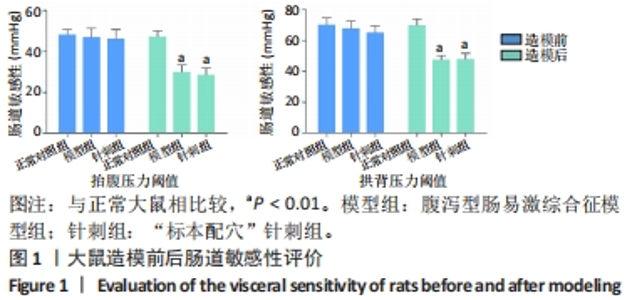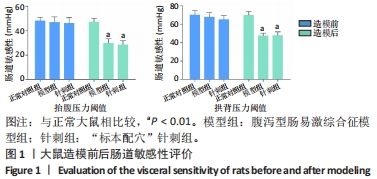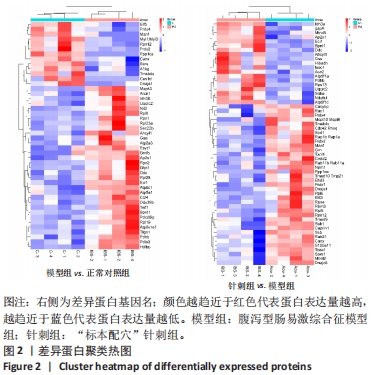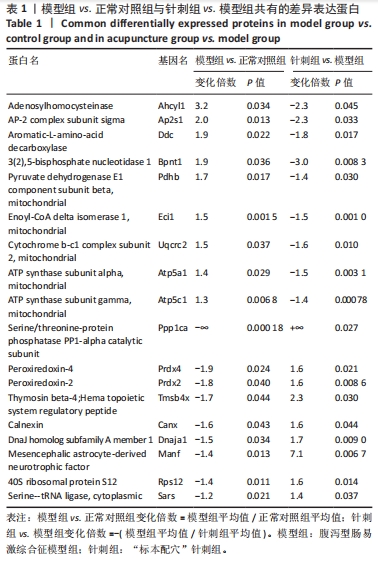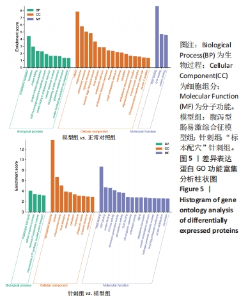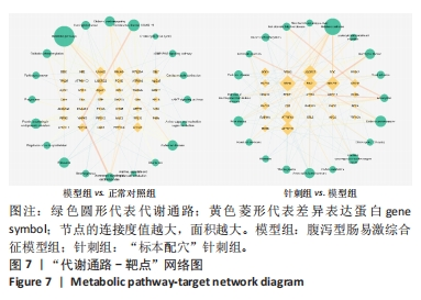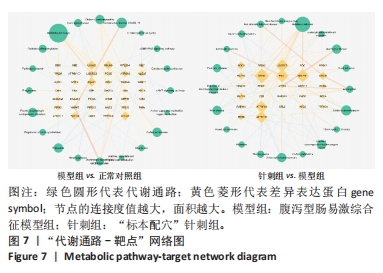Chinese Journal of Tissue Engineering Research ›› 2024, Vol. 28 ›› Issue (26): 4129-4136.doi: 10.12307/2024.421
Previous Articles Next Articles
Mechanisms of acupuncture in the treatment of irritable bowel syndrome with diarrhea based on proteomics
Liu Jing, Liang Fangyuan, Li Jia, Wang Hua
- Acupuncture-moxibustion and Orthopedic College, Hubei University of Chinese Medicine, Wuhan 430061, Hubei Province, China
-
Received:2023-06-25Accepted:2023-07-27Online:2024-09-18Published:2023-09-28 -
Contact:Li Jia, MD, Professor, Acupuncture-moxibustion and Orthopedic College, Hubei University of Chinese Medicine, Wuhan 430061, Hubei Province, China -
About author:Liu Jing, Master, Experimentalist, Acupuncture-moxibustion and Orthopedic College, Hubei University of Chinese Medicine, Wuhan 430061, Hubei Province, China -
Supported by:the National Natural Science Foundation of China, No. 81804165 (to LJ); Natural Science Foundation of Hubei Province (General Program), No. 2023AFB960 (to LJ); Hubei Provincial Department of Education Scientific Research Program, No. Q20202005 (to LJ)
CLC Number:
Cite this article
Liu Jing, Liang Fangyuan, Li Jia, Wang Hua. Mechanisms of acupuncture in the treatment of irritable bowel syndrome with diarrhea based on proteomics[J]. Chinese Journal of Tissue Engineering Research, 2024, 28(26): 4129-4136.
share this article
Add to citation manager EndNote|Reference Manager|ProCite|BibTeX|RefWorks

通过维恩分析探究不同比较组间差异蛋白的重叠关系。结果显示,模型组vs.正常对照组与针刺组vs.模型组有18个共有的差异表达蛋白(调控方向相反),这18个差异蛋白与“标本配穴”针刺治疗IBS-D的效应机制密切相关。进一步分析显示,针刺可逆转模型组9个差异表达蛋白的上调和9个差异表达蛋白的下调,见图3,表1。其中包括5个与能量代谢相关的蛋白(Atp5a1、Atp5c1、Pdhb、Sars、Uqcrc2)、2个与细胞抗氧化应激保护相关的蛋白(Prdx2、Prdx4)以及与平滑肌功能相关的 3个蛋白(Ppp1ca、Manf、Tmsb4x)。说明针刺对IBS-D的调控效应可能与能量代谢及抗氧化应激保护相关。"
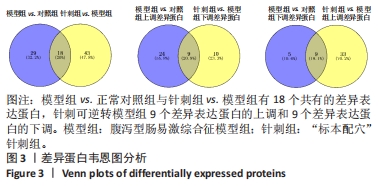
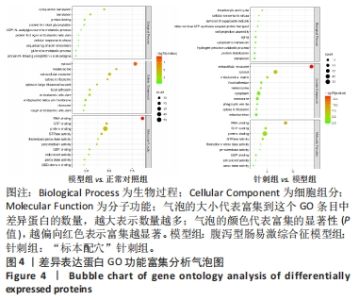
2.4 差异表达蛋白GO功能富集分析 为了进一步探究IBS-D致病分子机制及“标本配穴”针刺的效应机制,对差异表达蛋白进行了GO功能聚类分析。结果显示,模型组vs.正常对照组中,生物过程主要涉及细胞质翻译、翻译、蛋白折叠、蛋白N-连接糖基化、糖胺代谢过程等;细胞组分主要涉及胞质、黑素小体、细胞外泌体、胞质核糖体、细胞质大核糖体亚单位等;分子功能主要涉及RNA结合、GTP结合、蛋白结合、GTP酶活性、硫氧还蛋白过氧化物酶活性等。针刺组vs.模型组差异蛋白GO聚类中生物过程主要涉及三羧酸循环、细胞应激反应、超氧自由基清除、线粒体ATP合成耦联质子转运、单元投影组装等;细胞组分主要涉及细胞外泌体、胞质、线粒体基质、黏着斑、黑素小体等;分子功能主要涉及RNA结合、GTP结合、蛋白结合、GTP酶活性、硫氧还蛋白活性等。各组生物过程、细胞组分、分子功能3个分支富集显著性排名前10的条目见图4;各组富集显著性排名30的GO组见图5。"
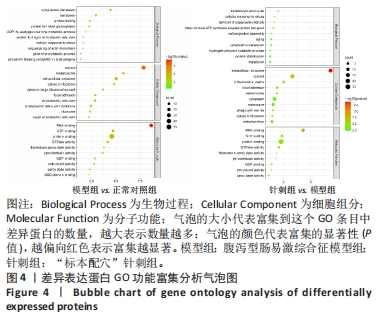

2.5 与IBS-D疾病及“标本配穴”针刺效应相关的代谢通路及靶点分析 使用David及KOBAS数据库对不同比较组间的差异蛋白进行KEGG代谢通路分析。检索结果显示,模型组vs.正常对照组的差异蛋白总共涉及62条信号通路,富集显著性排名前20的KEGG代谢通路见图6,包括糖尿病性心肌病、心肌细胞肾上腺素信号、心肌收缩、cGMP-PKG、cAMP信号通路、肌动蛋白细胞骨架调节等与平滑肌功能相关的信号通路。利用Cytoscape软件对富集显著性较高的信号通路进行可视化分析,构建“代谢通路-靶点”网络图,见图7。拓扑分析显示,此网络共有61个节点,80条边。度值排名前10位的靶点为:Uqcrc2、Mapk3、Atp2a3、Ppp1ca、Atp5a1、Atp5c1、Gfpt1、Pdhb、Atp6v1e1、Rpl8,其中Ppp1ca与Mapk3的度值最大,参与的代谢通路最多。Ppp1ca为苏氨酸蛋白磷酸酶亚单位,与肌肉收缩及蛋白合成相关,此蛋白在正常组和针刺组表达,在模型组并未检测到。Mapk3参与MAPK信号通路,此通路被证实与内脏敏感性相关。Ppp1ca与Mapk3的表达调控可能与IBS-D的致病机制及“标本配穴”针刺的调控作用相关。"
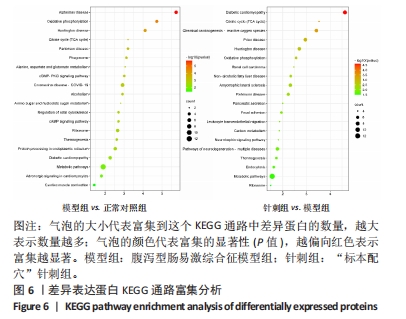
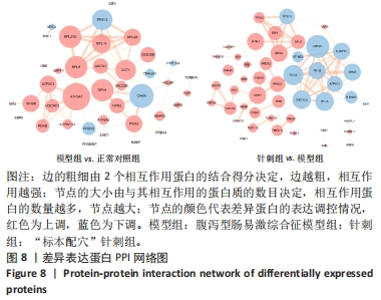
针刺组vs.模型组差异蛋白总共涉及62条信号通路,其中糖尿病性心肌病、柠檬酸循环、化学致癌作用-活性氧、朊病毒病、亨廷顿舞蹈病、氧化磷酸化、肾细胞癌、非酒精性脂肪性肝病、内吞作用、肌萎缩侧索硬化症等为富集度较高的代谢通路。利用Cytoscape软件对富集显著性排名前20的信号通路进行可视化分析,构建“代谢通路-靶点”网络图,见图7。此网络包含47个节点,115条边。度值排名前10位的靶点为:Sdha、Uqcrc2、Ndufs1、Rac1、Atp5a1、Atp5c1、Sod1、Cdc42、Rap1a、Rap1b。 2.6 “标本配穴”针刺对IBS-D的效应机制与能量代谢及抗氧化应激保护相关 为了探究差异蛋白之间的相互作用关系,通过STRING数据库和Cytoscape 3.7.1软件构建蛋白-蛋白相互作用网络(protein-protein Interactions,PPI)。模型组vs.正常对照组47个差异蛋白中有39个参与了蛋白互作网络。此网络共有39个节点,80条边,见图8。MCL聚类分析鉴定出11个蛋白簇。其中有1个与能量代谢相关的蛋白簇差异蛋白的数量最多,包含Atp5a1、Atp5c1、Pdhb、Uqcrc2、Atp6v1e1、Atp2a3、Idh3B,此蛋白簇的蛋白表达均发生了下调,见图8。使用Network Analyzer分析工具进行网络拓扑分析,结果显示,度值排名前10位的关键蛋白分别为:Atp5a1、Atp5c1、Canx、Rpl8、Rpl23a、Rpn1、Rps12、Cct4、Rpl19、Idh3b。"
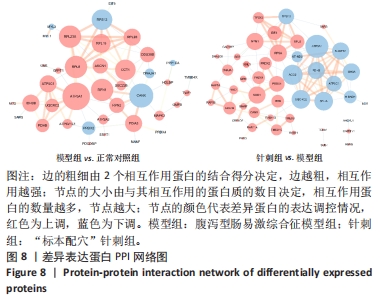

针刺组vs.模型组的61个差异蛋白中有47个蛋白存在相互作用关系。此PPI网络共有47个节点,121条边。MCL聚类分析显示网络包含11个蛋白簇,其中有2个蛋白簇的差异蛋白数量最多,可能与“标本配穴”针刺的干预效应密切相关。第1个蛋白质簇由与能量代谢相关的10个蛋白质组成,包括Aco2、Atp5c1、Uqcrc2、Sdha、Idh3a、Ndufs1、Pdhb、Atp5a1、Mt-nd5和Sars,见图8;此蛋白簇的蛋白均发生了下调,表明“标本配穴”针刺逆转了IBS-D所造成的能量代谢的损伤。第2个蛋白簇由与细胞抗氧化应激保护相关的6个蛋白质组成,包括Grn、Prdx1、Prdx2、Prdx4、Sod1和Txnl1,此蛋白簇的蛋白均发生了上调,可能是针刺干预IBS-D发挥抗氧化应激保护及抗炎的作用的机制之一。网络拓扑分析结果显示,此网络中度值排名前10位的关键蛋白为:Atp5a1、Aco2、Uqcrc2、Sdha、Sod1、Ndufs1、Pdhb、Idh3a、Rpsa和Npm1。"

| [1] IKECHI R, FISCHER BD, DESIPIO J, et al. Irritable bowel syndrome: clinical manifestations, dietary influences, and management. Healthcare (Basel). 2017; 5(2):21. [2] LI J, YUAN B, LI G, et al. Convergent syndromic atrophy of pain and emotional systems in patients with irritable bowel syndrome and depressive symptoms. Neurosci Lett. 2020;723:134865. [3] 戎新倩, 舒青龙. 基于脑-肠-微生物轴的肠易激综合征机制与治疗研究进展[J/OL]. 微生物学通报,2023. doi: 10.13344/j.microbiol.china.230253. [4] CARBONE F, VAN DEN HOUTE K, BESARD L, et al. Diet or medication in primary care patients with IBS: the DOMINO study - a randomised trial supported by the Belgian Health Care Knowledge Centre (KCE Trials Programme) and the Rome Foundation Research Institute. Gut. 2022;71(11):2226-2232. [5] WU IXY, WONG CHL, HO RST, et al. Acupuncture and related therapies for treating irritable bowel syndrome: overview of systematic reviews and network meta-analysis. Therap Adv Gastroenterol. 2019;12:1756284818820438. [6] SHI YZ, TAO QF, QIN D, et al. Acupuncture vs. antispasmodics in the treatment of irritable bowel syndrome: An adjusted indirect treatment comparison meta-analysis. Front Physiol. 2022;13:1001978. [7] BAO C, WU L, SHI Y, et al. Long-term effect of moxibustion on irritable bowel syndrome with diarrhea: a randomized clinical trial. Therap Adv Gastroenterol. 2022;15:17562848221075131. [8] 张艳佶, 陈祥林, 杨丹, 等. 针灸治疗腹泻型肠易激综合征的网状Meta分析[J]. 针灸临床杂志,2022,38(7):53-59. [9] 李方文卉, 唐宏图. “标本配穴”电针对腹泻型肠易激综合征模型大鼠内脏高敏感性及紧密连接相关因子的影响[J]. 针灸临床杂志,2021,37(10):71-76. [10] 付伊萌. 基于代谢组学技术探究标本配穴针灸防治腹泻型肠易激综合征的效应机制[D]. 武汉:湖北中医药大学,2022. [11] LI Y, PENG S, LIANG F, et al. Effectiveness of acupuncture for irritable bowel syndrome: Protocol for a scoping review of systematic reviews and meta-analyses.Medicine (Baltimore). 2022;101(29):e29218. [12] LI J, LU W, LI YC, et al. Electroacupuncture Attenuates Depressive Disorder and Gastrointestinal Dysfunction in Myocardial Hypertrophy via Upregulation of 5-HT on Rats. Acupuncture & Electro-Therapeutics Research. 2022;47(3): 356-367. [13] 李佳, 薛艳, 杨大业,等. 电针足三里穴对肠易激综合征大鼠平滑肌收缩功能及皮层肌动蛋白表达的影响[J]. 广州中医药大学学报,2018,35(2):272-276. [14] 刘娇萍, 杨大业, 冉国平, 等. 电针足三里穴对肠易激综合征大鼠平滑肌收缩蛋白vimentin的影响[J]. 吉林中医药,2018,38(8):940-943. [15] LI S, FEI G, FANG X, et al. Changes in Enteric Neurons of Small Intestine in a Rat Model of Irritable Bowel Syndrome with Diarrhea. J Neurogastroenterol Motil. 2016;22(2):310-320. [16] 郑苏,胥婧,彭力. 电针足三里对肠易激综合征大鼠胃肠功能及CGRP、SP、VIP影响研究[J]. 针灸临床杂志,2018,34(3):66-69. [17] 中国针灸学会.实验动物常用穴位名称与定位第2部分:大鼠[J]. 针刺研究, 2021,46(4):351-352. [18] MINOWA T, OHTSUKA S, SASAI H, et al. Proteomic analysis of the small intestine and colon epithelia of adenomatous polyposis coli gene-mutant mice by two-dimensional gel electrophoresis. Electrophoresis. 2000;21(9):1782-1786. [19] COX J, MANN M. MaxQuant enables high peptide identification rates, individualized p.p.b.-range mass accuracies and proteome-wide protein quantification. Nat biotechnol. 2008;26(12):1367-1372. [20] BAI T, XIA J, JIANG Y, et al. Comparison of the Rome IV and Rome III criteria for IBS diagnosis: A cross-sectional survey. J Gastroenterol Hepatol. 2017;32(5):1018-1025. [21] ALTOMARE A, DI ROSA C, IMPERIA E, et al. Diarrhea Predominant-Irritable Bowel Syndrome (IBS-D): Effects of Different Nutritional Patterns on Intestinal Dysbiosis and Symptoms. Nutrients. 2021;13(5):1506. [22] ZHANG B, XUE H, WANG W, et al. Comparative proteomic analysis of the brain and colon in three rat models of irritable bowel syndrome. Proteome Sci. 2020; 18:1. [23] 吴帆,王华,吴松,等.王华教授运用“标本配穴”针灸法治疗肠腑病证经验[J].时珍国医国药,2021,32(3):729-731. [24] 梁众擎, 赵霞, 邢琼琼,等. 基于系统生物学的中医药发展探析[J].中华中医药杂志,2019;34(12):5537-5539. [25] GOO YA, CAIN K, JARRETT M, et al. Shulman and Margaret Heitkemper. Urinary proteome analysis of irritable bowel syndrome (IBS) symptom subgroups. J Proteome Res. 2012;11(12):5650-5662. [26] PATEL SA, PATEL N, OKWU V, et al. Analysis of exhaled volatile organic compounds reveals new biomarkers for irritable bowel syndrome. Am Coll Gastroenterol (ACG), 2014, Annual Scientific Meeting: Abstract 12. [27] 李依洁. 基于脑-肠互动温肾健脾法干预腹泻型肠易激综合征的蛋白组学研究[D].北京:北京中医药大学,2017. [28] SPILLER R, AZIZ Q, CREED F, et al. Guidelines on the irritable bowel syndrome: mechanisms and practical management. Gut. 2007;56(12):1770-1798. [29] FORD AC, SPERBER AD, CORSETTI M, et al.Irritable bowel syndrome. Lancet. 2020;396(10263):1675-1688. [30] MANABE N, WONG BS, CAMILLERI M, et al. Lower functional gastrointestinal disorders: evidence of abnormal colonic transit in a 287 patient cohort. Neurogastroenterol Motil. 2010;22(3):293-e82. [31] YI L, SUN H, ZHANG H, et al. Down-regulation of HTR1Amodulated ACC activation contributes to stress-induced visceral hyperalgesia in rat. Neurogastro enterol Motil. 2019;31(8):e13620. [32] QI Q, CHEN F, ZHANG W, et al. Colonic N-methyl-d-aspartate receptor contributes to visceral hypersensitivity in irritable bowel syndrome. J Gastroenterol Hepatol. 2017;32(4):828-836. [33] 邰昭霞,费雪瑜,瞿思颖,等. 电针对糖尿病神经痛大鼠脊髓背角NF-κB p65蛋白的干预作用[J]. 中国实验动物学报,2020,28(1):43-48. [34] FISCHER SG, PEREZ RS, NOUTA J, et al. Oxidative stress in Complex Regional Pain Syndrome (CRPS): no systemically elevated levels of malondialdehyde, F2-isoprostanes and 8OHdG in a selected sample of patients.Int J Mol Sci. 2013; 14(4):7784-7794. [35] 李晓洁,尹诚语,郑小莉,等. 电针对复杂性区域疼痛综合征I型大鼠模型局部组织氧化应激反应的干预作用[J]. 中国实验动物学报,2020,28(5):593-601. |
| [1] | Huang Xiarong, Hu Lizhi, Sun Guanghua, Peng Xinke, Liao Ying, Liao Yuan, Liu Jing, Yin Linwei, Zhong Peirui, Peng Ting, Zhou Jun, Qu Mengjian. Effect of electroacupuncture on the expression of P53 and P21 in articular cartilage and subchondral bone of aged rats with knee osteoarthritis [J]. Chinese Journal of Tissue Engineering Research, 2024, 28(8): 1174-1179. |
| [2] | Li Longyang, Zhang Songjiang, Zhao Xianmin, Zhou Chunguang, Gao Jianfeng. Electroacupuncture intervention on the proliferation and differentiation of hippocampal neurons and oligodendrocytes in Alzheimer’s disease model mice [J]. Chinese Journal of Tissue Engineering Research, 2024, 28(7): 1029-1035. |
| [3] | Jiao Ziyuan, Zhuo Yue, Liang Roujun, Ding Qiangsheng, Zeng Xuejiu, Xu Ming, Zhang Hong. Electroacupuncture improves morphological structure of the detrusor muscle and bladder function in rats with spinal cord injury [J]. Chinese Journal of Tissue Engineering Research, 2024, 28(28): 4484-4490. |
| [4] | Liu Yuhang, Sun Ruifen, Mu Rigen Jiya, Wang Xing, Li Zhijun, Liu Yanan, Hao Yunteng, Cai Yongqiang, Zhang Shaojie, Li Kun. Development of a three-dimensional digital children’s acupuncture point visualization system of Mongolian medicine [J]. Chinese Journal of Tissue Engineering Research, 2024, 28(20): 3223-3228. |
| [5] | Huang Huimin, Xie Bingying, Huang Jingwen, Huang Xiaobin, Xie Lihua, Li Shengqiang, Ge Jirong. Protective mechanism of alendronate granule in a rat osteoporosis model based on TMT proteomic analysis [J]. Chinese Journal of Tissue Engineering Research, 2024, 28(16): 2505-2511. |
| [6] | Yuan Tianyi, Liu Hongjiang, Yang Zengqiang, Lu Xingbao, Maimaitiyibubaji, Zhou Zhiheng, Cui Yong. Identification of differences in N6-methyladenosine-related genes in steroid-induced femoral head necrosis [J]. Chinese Journal of Tissue Engineering Research, 2024, 28(14): 2159-2165. |
| [7] | Luo Fu, Shu Xiangzhong, Liu Danni, Tan Jinqu, Peng Ting, Huang Xiarong, Sun Guanghua, Peng Xinke, Wang Jinling, Zhou Jun. Electroacupuncture reduces inflammatory factor expression by suppressing Toll-like receptor 4/nuclear factor-kappa B signaling in rats with cerebral ischemia-reperfusion injury [J]. Chinese Journal of Tissue Engineering Research, 2024, 28(14): 2186-2190. |
| [8] | Bu Xianzhong, Bu Baoxian, Xu Wei, Li Zhifei, Yang Hanli, Wang Weiwei, Zhou Jinyan, Zhong Yuanming. Serum differential proteomics between developmental cervical spinal stenosis and cervical spondylotic myelopathy [J]. Chinese Journal of Tissue Engineering Research, 2024, 28(11): 1704-1711. |
| [9] | Zhang Chi, Zhang Xiaoyun, Chai Yuan, Chen Feng. Proteomic study of Jintiange capsule in the treatment of retinoic acid-induced osteoporosis rats [J]. Chinese Journal of Tissue Engineering Research, 2023, 27(35): 5634-5641. |
| [10] | Ma Dujun, Zhu Houjun, Liu Leshi, Peng Liping, Zhao Jing, Liao Zhouwei. Proteomic analysis on cartilage differentiation of rabbit bone marrow mesenchymal stem cells induced by Achyranthes bidentata alcohol extract [J]. Chinese Journal of Tissue Engineering Research, 2023, 27(24): 3795-3802. |
| [11] | Duan Zhaoyuan, Wu Mingli, Luo Meng, Liu Chengmei, Gao Jing, Li Ruiqing, Feng Xiaodong. Effect of electroacupuncture modulation of glycogen synthase kinase 3 beta/beta-catenin signaling pathway on CD133 protein expression in rat ventricular zone cells after spinal cord injury [J]. Chinese Journal of Tissue Engineering Research, 2023, 27(24): 3858-3864. |
| [12] | Niu Yuqing, Qin Hewei, Li Yanjie, Song Xuemei, Wang Mengnan, Sun Mengyan. Eye acupuncture can promote angiogenesis by regulating the expression of angiogenic factors in cerebral ischemia model rats [J]. Chinese Journal of Tissue Engineering Research, 2023, 27(23): 3674-3681. |
| [13] | Li Yangjie, Qi Rong, Zhang Xinyu, Cheng Jiaji, Zhou Ning, Cui Xue, Cheng Shuang, Wang Zhengdong, Yan Nan. Neuroprotective effects of sodium butyrate and acetylation proteomics analysis in fluorosis rats [J]. Chinese Journal of Tissue Engineering Research, 2023, 27(20): 3151-3157. |
| [14] | Yao Haihua, Min Youjiang, Hong Dongying, Wang Li, Lu Xiuyun, Yang Yihua. Effects of Santong electroacupuncture on the activity of cytoplasmic phospholipase A2 in rats with spinal cord injury via the Rho/Rho kinase and MEK/ERK signaling pathways [J]. Chinese Journal of Tissue Engineering Research, 2023, 27(20): 3158-3166. |
| [15] | Cui Zhenhua, Lin Xiafei, Chen Yongmin, Lin Ye, Li Guanyu, Song Zhenhua. Acupuncture and moxibustion combined with rehabilitation therapy improve neurological function and intestinal flora following cerebral ischemia in rats [J]. Chinese Journal of Tissue Engineering Research, 2023, 27(17): 2692-2698. |
| Viewed | ||||||
|
Full text |
|
|||||
|
Abstract |
|
|||||
